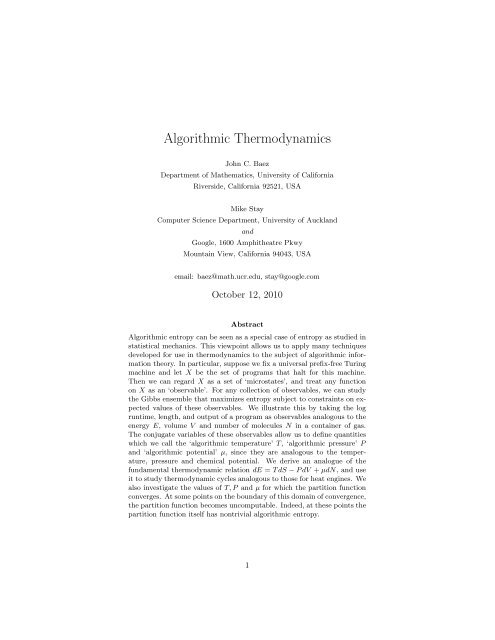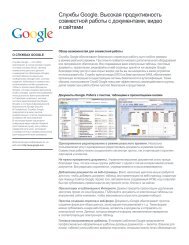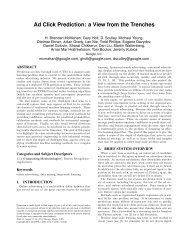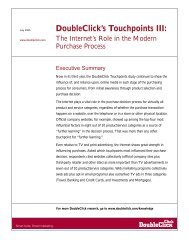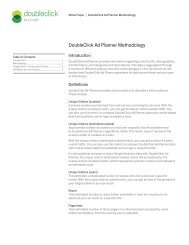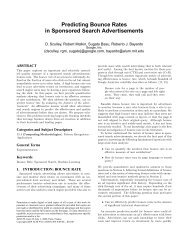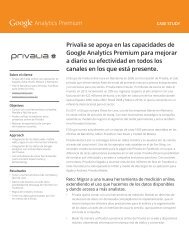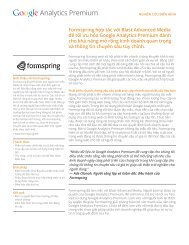Algorithmic Thermodynamics
Algorithmic Thermodynamics
Algorithmic Thermodynamics
Create successful ePaper yourself
Turn your PDF publications into a flip-book with our unique Google optimized e-Paper software.
<strong>Algorithmic</strong> <strong>Thermodynamics</strong>John C. BaezDepartment of Mathematics, University of CaliforniaRiverside, California 92521, USAMike StayComputer Science Department, University of AucklandandGoogle, 1600 Amphitheatre PkwyMountain View, California 94043, USAemail: baez@math.ucr.edu, stay@google.comOctober 12, 2010Abstract<strong>Algorithmic</strong> entropy can be seen as a special case of entropy as studied instatistical mechanics. This viewpoint allows us to apply many techniquesdeveloped for use in thermodynamics to the subject of algorithmic informationtheory. In particular, suppose we fix a universal prefix-free Turingmachine and let X be the set of programs that halt for this machine.Then we can regard X as a set of ‘microstates’, and treat any functionon X as an ‘observable’. For any collection of observables, we can studythe Gibbs ensemble that maximizes entropy subject to constraints on expectedvalues of these observables. We illustrate this by taking the logruntime, length, and output of a program as observables analogous to theenergy E, volume V and number of molecules N in a container of gas.The conjugate variables of these observables allow us to define quantitieswhich we call the ‘algorithmic temperature’ T, ‘algorithmic pressure’ Pand ‘algorithmic potential’ µ, since they are analogous to the temperature,pressure and chemical potential. We derive an analogue of thefundamental thermodynamic relation dE = TdS − PdV + µdN, and useit to study thermodynamic cycles analogous to those for heat engines. Wealso investigate the values of T, P and µ for which the partition functionconverges. At some points on the boundary of this domain of convergence,the partition function becomes uncomputable. Indeed, at these points thepartition function itself has nontrivial algorithmic entropy.1
1 IntroductionMany authors [1, 6, 9, 12, 16, 24, 26, 28] have discussed the analogy betweenalgorithmic entropy and entropy as defined in statistical mechanics: that is,the entropy of a probability measure p on a set X. It is perhaps insufficientlyappreciated that algorithmic entropy can be seen as a special case of the entropyas defined in statistical mechanics. We describe how to do this in Section 3.This allows all the basic techniques of thermodynamics to be imported toalgorithmic information theory. The key idea is to take X to be some version of‘the set of all programs that eventually halt and output a natural number’, andlet p be a Gibbs ensemble on X. A Gibbs ensemble is a probability measure thatmaximizes entropy subject to constraints on the mean values of some observables— that is, real-valued functions on X.In most traditional work on algorithmic entropy, the relevant observableis the length of the program. However, much of the interesting structure ofthermodynamics only becomes visible when we consider several observables.When X is the set of programs that halt and output a natural number, someother important observables include the output of the program and logarithmof its runtime. So, in Section 4 we illustrate how ideas from thermodynamicscan be applied to algorithmic information theory using these three observables.To do this, we consider a Gibbs ensemble of programs which maximizesentropy subject to constraints on:• E, the expected value of the logarithm of the program’s runtime (whichwe treat as analogous to the energy of a container of gas),• V , the expected value of the length of the program (analogous to thevolume of the container), and• N, the expected value of the program’s output (analogous to the numberof molecules in the gas).This measure is of the formp = 1 (x)−δN(x)e−βE(x)−γVZfor certain numbers β, γ, δ, where the normalizing factorZ = ∑ x∈X−βE(x)−γV (x)−δN(x)eis called the ‘partition function’ of the ensemble. The partition function reducesto Chaitin’s number Ω when β = 0, γ = ln 2 and δ = 0. This number is uncomputable[6]. However, we show that the partition function Z is computablewhen β > 0, γ ≥ ln 2, and δ ≥ 0.We derive an algorithmic analogue of the basic thermodynamic relationHere:dE = TdS − PdV + µdN.2
• S is the entropy of the Gibbs emsemble,• T = 1/β is the ‘algorithmic temperature’ (analogous to the temperatureof a container of gas). Roughly speaking, this counts how many times youmust double the runtime in order to double the number of programs inthe ensemble while holding their mean length and output fixed.• P = γ/β is the ‘algorithmic pressure’ (analogous to pressure). Thismeasures the tradeoff between runtime and length. Roughly speaking,it counts how much you need to decrease the mean length to increase themean log runtime by a specified amount, while holding the number ofprograms in the ensemble and their mean output fixed.• µ = −δ/β is the ‘algorithmic potential’ (analogous to chemical potential).Roughly speaking, this counts how much the mean log runtime increaseswhen you increase the mean output while holding the number of programsin the ensemble and their mean length fixed.Starting from this relation, we derive analogues of Maxwell’s relations andconsider thermodynamic cycles such as the Carnot cycle or Stoddard cycle. Forthis we must introduce concepts of ‘algorithmic heat’ and ‘algorithmic work’.Charles Babbage described a computer powered by a steam engine; we describea heat engine powered by programs! We admit that the significance ofthis line of thinking remains a bit mysterious. However, we hope it points theway toward a further synthesis of algorithmic information theory and thermodynamics.We call this hoped-for synthesis ‘algorithmic thermodynamics’.2 Related WorkLi and Vitányi use the term ‘algorithmic thermodynamics’ for describing physicalstates using a universal prefix-free Turing machine U. They look at the3
smallest program p that outputs a description x of a particular microstate tosome accuracy, and define the physical entropy to beS A (x) = (k ln 2)(K(x) + H x ),where K(x) = |p| and H x embodies the uncertainty in the actual state givenx. They summarize their own work and subsequent work by others in chaptereight of their book [17]. Whereas they consider x = U(p) to be a microstate,we consider p to be the microstate and x the value of the observable U. Thentheir observables O(x) become observables of the form O(U(p)) in our model.Tadaki [27] generalized Chaitin’s number Ω to a function Ω D and showedthat the value of this function is compressible by a factor of exactly D whenD is computable. Calude and Stay [5] pointed out that this generalization wasformally equivalent to the partition function of a statistical mechanical systemwhere temperature played the role of the compressibility factor, and studiedvarious observables of such a system. Tadaki [28] then explicitly constructeda system with that partition function: given a total length E and number ofprograms N, the entropy of the system is the log of the number of E-bit stringsin dom(U) N . The temperature is1T = ∆E∆S ∣ .NIn a follow-up paper [29], Tadaki showed that various other quantities like thefree energy shared the same compressibility properties as Ω D . In this paper,we consider multiple variables, which is necessary for thermodynamic cycles,chemical reactions, and so forth.Manin and Marcolli [20] derived similar results in a broader context andstudied phase transitions in those systems. Manin [18, 19] also outlined anambitious program to treat the infinite runtimes one finds in undecidable problemsas singularities to be removed through the process of renormalization. Ina manner reminiscent of hunting for the proper definition of the “one-elementfield” F un , he collected ideas from many different places and considered howthey all touch on this central theme. While he mentioned a runtime cutoff asbeing analogous to an energy cutoff, the renormalizations he presented are uncomputable.In this paper, we take the log of the runtime as being analogousto the energy; the randomness described by Chaitin and Tadaki then arises asthe infinite-temperature limit.3 <strong>Algorithmic</strong> EntropyTo see algorithmic entropy as a special case of the entropy of a probabilitymeasure, it is useful to follow Solomonoff [24] and take a Bayesian viewpoint.In Bayesian probability theory, we always start with a probability measure calleda ‘prior’, which describes our assumptions about the situation at hand beforewe make any further observations. As we learn more, we may update this4
prior. This approach suggests that we should define the entropy of a probabilitymeasure relative to another probability measure — the prior.A probability measure p on a finite set X is simply a function p: X → [0, 1]whose values sum to 1, and its entropy is defined as follows:S(p) = − ∑ x∈Xp(x)ln p(x).But we can also define the entropy of p relative to another probability measureq:S(p, q) = − ∑ p(x)ln p(x)q(x) .x∈XThis relative entropy has been extensively studied and goes by various othernames, including ‘Kullback–Leibler divergence’ [13] and ‘information gain’ [23].The term ‘information gain’ is nicely descriptive. Suppose we initially assumethe outcome of an experiment is distributed according to the probabilitymeasure q. Suppose we then repeatedly do the experiment and discover its outcomeis distributed according to the measure p. Then the information gained isS(p, q).Why? We can see this in terms of coding. Suppose X is a finite set of signalswhich are randomly emitted by some source. Suppose we wish to encode thesesignals as efficiently as possible in the form of bit strings. Suppose the sourceemits the signal x with probability p(x), but we erroneously believe it is emittedwith probability q(x). Then S(p, q)/ ln2 is the expected extra message-lengthper signal that is required if we use a code that is optimal for the measure qinstead of a code that is optimal for the true measure, p.The ordinary entropy S(p) is, up to a constant, just the relative entropy inthe special case where the prior assigns an equal probability to each outcome.In other words:S(p) = S(p, q 0 ) + S(q 0 )when q 0 is the so-called ‘uninformative prior’, with q 0 (x) = 1/|X| for all x ∈ X.We can also define relative entropy when the set X is countably infinite. Asbefore, a probability measure on X is a function p: X → [0, 1] whose values sumto 1. And as before, if p and q are two probability measures on X, the entropyof p relative to q is defined byS(p, q) = − ∑ x∈Xp(x) ln p(x)q(x) . (1)But now the role of the prior becomes more clear, because there is no probabilitymeasure that assigns the same value to each outcome!In what follows we will take X to be — roughly speaking — the set ofall programs that eventually halt and output a natural number. As we shallsee, while this set is countably infinite, there are still some natural probabilitymeasures on it, which we may take as priors.5
To make this precise, we recall the concept of a universal prefix-free Turingmachine. In what follows we use string to mean a bit string, that is, a finite,possibly empty, list of 0’s and 1’s. If x and y are strings, let x||y be the concatenationof x and y. A prefix of a string z is a substring beginning with thefirst letter, that is, a string x such that z = x||y for some y. A prefix-freeset of strings is one in which no element is a prefix of any other. The domaindom(M) of a Turing machine M is the set of strings that cause M to eventuallyhalt. We call the strings in dom(M) programs. We assume that when the Mhalts on the program x, it outputs a natural number M(x). Thus we may thinkof the machine M as giving a function M : dom(M) → N.A prefix-free Turing machine is one whose halting programs form aprefix-free set. A prefix-free machine U is universal if for any prefix-free Turingmachine M there exists a constant c such that for each string x, there exists astring y withU(y) = M(x) and |y| < |x| + c.Let U be a universal prefix-free Turing machine. Then we can define someprobability measures on X = dom(U) as follows. Let| · |: X → Nbe the function assigning to each bit string its length. Then there is for anyconstant γ > ln 2 a probability measure p given byp(x) = 1 Z e−γ|x| .Here the normalization constant Z is chosen to make the numbers p(x) sum to1:Z = ∑ x∈Xe −γ|x| .It is worth noting that for computable real numbers γ ≥ ln 2, the normalizationconstant Z is uncomputable [27]. Indeed, when γ = ln 2, Z is Chaitin’s famousnumber Ω. We return to this issue in Section 4.5.Let us assume that each program prints out some natural number as itsoutput. Thus we have a functionN : X → Nwhere N(x) equals i when program x prints out the number i. We may use thisfunction to ‘push forward’ p to a probability measure q on the set N. Explicitly:∑q(i) = e −γ|x| .x∈X:N(x)=iIn other words, if i is some natural number, q(i) is the probability that a programrandomly chosen according to the measure p will print out this number.6
Given any natural number n, there is a probability measure δ n on N thatassigns probability 1 to this number:{1 if m = nδ n (m) =0 otherwise.We can compute the entropy of δ n relative to q:S(δ n , q)= − ∑ i∈N⎛= − ln ⎝δ n (i) ln δ n(i)q(i)∑x∈X : N(x)=ne −γ|x| ⎞⎠ + lnZ.(2)Since the quantity lnZ is independent of the number n, and uncomputable, itmakes sense to focus attention on the other part of the relative entropy:⎛⎞∑− ln⎝e −γ|x| ⎠.x∈X : N(x)=nIf we take γ = ln 2, this is precisely the algorithmic entropy [7, 16] of thenumber n. So, up to the additive constant lnZ, we have seen that algorithmicentropy is a special case of relative entropy.One way to think about entropy is as a measure of surprise: if you canpredict what comes next — that is, if you have a program that can compute itfor you — then you are not surprised. For example, the first 2000 bits of thebinary fraction for 1/3 can be produced with this short Python program:print "01" * 1000But if the number is complicated, if every bit is surprising and unpredictable,then the shortest program to print the number does not do any computation atall! It just looks something likeprint "101000011001010010100101000101111101101101001010"Levin’s coding theorem [15] says that the difference between the algorithmicentropy of a number and its Kolmogorov complexity — the length of theshortest program that outputs it — is bounded by a constant that only dependson the programming language.So, up to some error bounded by a constant, algorithmic information is informationgain. The algorithmic entropy is the information gained upon learninga number, if our prior assumption was that this number is the output of a randomlychosen program — randomly chosen according to the measure p whereγ = ln 2.So, algorithmic entropy is not just analogous to entropy as defined in statisticalmechanics: it is a special case, as long as we take seriously the Bayesian7
philosophy that entropy should be understood as relative entropy. This realizationopens up the possibility of taking many familiar concepts from thermodynamics,expressed in the language of statistical mechanics, and finding theircounterparts in the realm of algorithmic information theory.But to proceed, we must also understand more precisely the role of themeasure p. In the next section, we shall see that this type of measure is alreadyfamiliar in statistical mechanics: it is a Gibbs ensemble.4 <strong>Algorithmic</strong> <strong>Thermodynamics</strong>Suppose we have a countable set X, finite or infinite, and supposeC 1 , . . . , C n : X → R is some collection of functions. Then we may seek a probabilitymeasure p that maximizes entropy subject to the constraints that themean value of each observable C i is a given real number C i :∑p(x)C i (x) = C i .x∈XAs nicely discussed by Jaynes [10, 11], the solution, if it exists, is the so-calledGibbs ensemble:p(x) = 1 Z e−(s1C1(x)+···+snCn(x))for some numbers s i ∈ R depending on the desired mean values C i . Here thenormalizing factor Z is called the partition function:Z = ∑ x∈Xe −(s1C1(x)+···+snCn(x)) .In thermodynamics, X represents the set of microstates of some physicalsystem. A probability measure on X is also known as an ensemble. Each functionC i : X → R is called an observable, and the corresponding quantity s i iscalled the conjugate variable of that observable. For example, the conjugateof the energy E is the inverse of temperature T, in units where Boltzmann’sconstant equals 1. The conjugate of the volume V — of a piston full of gas, forexample — is the pressure P divided by the temperature. And in a gas containingmolecules of various types, the conjugate of the number N i of molecules ofthe ith type is minus the ‘chemical potential’ µ i , again divided by temperature.For easy reference, we list these observables and their conjugate variables below.8
THERMODYNAMICSObservableConjugate Variableenergy: Evolume: Vnumber: N i1TPT− µ iTNow let us return to the case where X = dom(U). Recalling that programsare bit strings, one important observable for programs is the length:We have already seen the measure| · |: X → N.p(x) = 1 Z e−γ|x| .Now its significance should be clear! This is the probability measure on programsthat maximizes entropy subject to the constraint that the mean length is someconstant l:∑p(x) |x| = l.x∈XSo, γ is the conjugate variable to program length.There are, however, other important observables that can be defined forprograms, and each of these has a conjugate quantity. To make the analogyto thermodynamics as vivid as possible, let us arbitrarily choose two more observablesand treat them as analogues of energy and the number of some typeof molecule. Two of the most obvious observables are ‘output’ and ‘runtime’.Since Levin’s computable complexity measure [14] uses the logarithm of runtimeas a kind of ‘cutoff’ reminiscent of an energy cutoff in renormalization, we shallarbitrarily choose the log of the runtime to be analogous to the energy, anddenote it asE : X → [0, ∞)Following the chart above, we use 1/T to stand for the variable conjugate to E.We arbitrarily treat the output of a program as analogous to the number of acertain kind of molecule, and denote it asN : X → N.We use −µ/T to stand for the conjugate variable of N. Finally, as alreadyhinted, we denote program length asV : X → N9
so that in terms of our earlier notation, V (x) = |x|. We use P/T to stand forthe variable conjugate to V .ALGORITHMSObservablelog runtime: Elength: Voutput: NConjugate Variable1TPT− µ TBefore proceeding, we wish to emphasize that the analogies here were chosensomewhat arbitrarily. They are merely meant to illustrate the application ofthermodynamics to the study of algorithms. There may or may not be a specific‘best’ mapping between observables for programs and observables for a containerof gas! Indeed, Tadaki [28] has explored another analogy, where length ratherthan log run time is treated as the analogue of energy. There is nothing wrongwith this. However, he did not introduce enough other observables to see thewhole structure of thermodynamics, as developed in Sections 4.1-4.2 below.Having made our choice of observables, we define the partition function byZ = ∑ x∈Xe − 1 T (E(x)+PV (x)−µN(x)) .When this sum converges, we can define a probability measure on X, the Gibbsensemble, byp(x) = 1 Z e− 1 T (E(x)+PV (x)−µN(x)) .Both the partition function and the probability measure are functions of T, Pand µ. From these we can compute the mean values of the observables to whichthese variables are conjugate:E = ∑ x∈Xp(x)E(x)V = ∑ x∈Xp(x)V (x)N = ∑ x∈Xp(x)N(x)In certain ranges, the map (T, P, µ) ↦→ (E, V , N) will be invertible. This allowsus to alternatively think of Z and p as functions of E, V , and N. In thissituation it is typical to abuse language by omitting the overlines which denote‘mean value’.10
4.1 Elementary RelationsThe entropy S of the Gibbs ensemble is given byS = − ∑ x∈Xp(x) lnp(x).We may think of this as a function of T, P and µ, or alternatively — as explainedabove — as functions of the mean values E, V, and N. Then simple calculations,familiar from statistical mechanics [22], show that∂S∂E∣ = 1 (3)V,NT∂S∂V ∣ = P (4)E,NT∂S∂N ∣ = − µE,VT . (5)We may summarize all these by writingor equivalentlydS = 1 T dE + P T dV − µ T dNdE = TdS − PdV + µdN. (6)Starting from the latter equation we see:∂E∂S ∣ = T (7)V,N∂E∂V∣ = −P (8)S,N∂E∂N ∣ = µ. (9)S,VWith these definitions, we can start to get a feel for what the conjugatevariables are measuring. To build intuition, it is useful to think of the entropyS as roughly the logarithm of the number of programs whose log runtimes,length and output lie in small ranges E ±∆E, V ±∆V and N ±∆N. This is atbest approximately true, but in ordinary thermodynamics this approximationis commonly employed and yields spectacularly good results. That is why inthermodynamics people often say the entropy is the logarithm of the numberof microstates for which the observables E, V and N lie within a small range oftheir specified values [22].If you allow programs to run longer, more of them will halt and give ananswer. The algorithmic temperature, T, is roughly the number of times11
you have to double the runtime in order to double the number of ways to satisfythe constraints on length and output.The algorithmic pressure, P, measures the tradeoff between runtime andlength [4]: if you want to keep the number of ways to satisfy the constraintsconstant, then the freedom gained by having longer runtimes has to be counterbalancedby shortening the programs. This is analogous to the pressure of gasin a piston: if you want to keep the number of microstates of the gas constant,then the freedom gained by increasing its energy has to be counterbalanced bydecreasing its volume.Finally, the algorithmic potential describes the relation between log runtimeand output: it is a quantitative measure of the principle that most largeoutputs must be produced by long programs.4.2 Thermodynamic CyclesOne of the first applications of thermodynamics was to the analysis of heatengines. The underlying mathematics applies equally well to algorithmic thermodynamics.Suppose C is a loop in (T, P, µ) space. Assume we are in a regionthat can also be coordinatized by the variables E, V, N. Then the change inalgorithmic heat around the loop C is defined to be∮∆Q = TdS.Suppose the loop C bounds a surface Σ. Then Stokes’ theorem implies that∮ ∫∆Q = TdS = dTdS.However, Equation (6) implies thatCdTdS = d(TdS) = d(dE + PdV − µdN) = +dPdV − dµdNsince d 2 = 0. So, we have∫∆Q = (dPdV − dµdN)or using Stokes’ theorem again∫∆Q =ΣCCΣ(PdV − µdN). (10)In ordinary thermodynamics, N is constant for a heat engine using gas in asealed piston. In this situation we have∫∆Q = PdV.This equation says that the change in heat of the gas equals the work done onthe gas — or equivalently, minus the work done by the gas. So, in algorithmicC12
thermodynamics, let us define ∫ PdV to be the algorithmic work done on ourCensemble of programs as we carry it around the loop C. Beware: this conceptis unrelated to ‘computational work’, meaning the amount of computation doneby a program as it runs.To see an example of a cycle in algorithmic thermodynamics, consider theanalogue of the heat engine patented by Stoddard in 1919 [25]. Here we fix Nto a constant value and consider the following loop in the PV plane:(P 2 , V 1 )1 2P(P 1 , V 1 )4(P 3 , V 2 )3(P 4 , V 2 )VWe start with an ensemble with algorithmic pressure P 1 and mean length V 1 .We then trace out a loop built from four parts:1. Isometric. We increase the pressure from P 1 to P 2 while keeping the meanlength constant. No algorithmic work is done on the ensemble of programsduring this step.2. Isentropic. We increase the length from V 1 to V 2 while keeping the numberof halting programs constant. High pressure means that we’re operating ina range of runtimes where if we increase the length a little bit, many moreprograms halt. In order to keep the number of halting programs constant,we need to shorten the runtime significantly. As we gradually increasethe length and lower the runtime, the pressure drops to P 3 . The totaldifference in log runtime is the algorithmic work done on the ensembleduring this step.3. Isometric. Now we decrease the pressure from P 3 to P 4 while keeping thelength constant. No algorithmic work is done during this step.4. Isentropic. Finally, we decrease the length from V 2 back to V 1 whilekeeping the number of halting programs constant. Since we’re at lowpressure, we need only increase the runtime a little. As we graduallydecrease the length and increase the runtime, the pressure rises slightlyback to P 1 . The total increase in log runtime is minus the algorithmicwork done on the ensemble of programs during this step.The total algorithmic work done on the ensemble per cycle is the difference inlog runtimes between steps 2 and 4.13
4.3 Further RelationsFrom the elementary thermodynamic relations in Section 4.1, we can derivevarious others. For example, the so-called ‘Maxwell relations’ are obtained bycomputing the second derivatives of thermodynamic quantities in two differentorders and then applying the basic derivative relations, Equations (7-9). Whiletrivial to prove, these relations say some things about algorithmic thermodynamicswhich may not seem intuitively obvious.We give just one example here. Since mixed partials commute, we have:∂ 2 E∂V ∂S ∣ = ∂2 EN∂S∂V ∣ .NUsing Equation (7), the left side can be computed as follows:∂ 2 E∂V ∂S ∣ = ∂∂EN∂V ∣S,N∂S ∣ = ∂T∣V,N∂V∣S,NSimilarly, we can compute the right side with the help of Equation (8):∂ 2 E∂S∂V ∣ = ∂∂EN∂S ∣V,N∂V ∣ = − ∂PS,N∂S ∣ .V,NAs a result, we obtain:∂T∂V∣ = − ∂PS,N∂S ∣ .V,NWe can also derive interesting relations involving derivatives of the partitionfunction. These become more manageable if we rewrite the partition functionin terms of the conjugate variables of the observables E, V , and N:β = 1 T , γ = P T , δ = − µ T . (11)Then we haveZ = ∑ x∈X−βE(x)−γV (x)−δN(x)eSimple calculations, standard in statistical mechanics [22], then allow us tocompute the mean values of observables as derivatives of the logarithm of Zwith respect to their conjugate variables. Here let us revert to using overlinesto denote mean values:E= ∑ x∈Xp(x)E(x)= − ∂∂β lnZV= ∑ x∈Xp(x)V (x)= − ∂∂γ lnZN = ∑ x∈Xp(x)N(x) = − ∂ ∂δ lnZ14
We can go further and compute the variance of these observables using secondderivatives:(∆E) 2= ∑ x∈Xp(x)(E(x) 2 − E 2 ) = ∂2∂ 2 β lnZand similarly for V and N. Higher moments of E, V and N can be computedby taking higher derivatives of lnZ.4.4 ConvergenceSo far we have postponed the crucial question of convergence: for which values ofT, P and µ does the partition function Z converge? For this it is most convenientto treat Z as a function of the variables β, γ and δ introduced in Equation (11).For which values of β, γ and δ does the partition function converge?First, when β = γ = δ = 0, the contribution of each program is 1. Sincethere are infinitely many halting programs, Z(0, 0, 0) does not converge.Second, when β = 0, γ = ln 2, and δ = 0, the partition function converges toChaitin’s numberΩ = ∑ x∈X2 −V (x) .To see that the partition function converges in this case, consider this mappingof strings to segments of the unit interval:empty0 100 01 10 11000 001 010 011 100 101 110 111.Each segment consists of all the real numbers whose binary expansion beginswith that string; for example, the set of real numbers whose binary expansionbegins 0.101 . . . is [0.101, 0.110) and has measure 2 −|101| = 2 −3 = 1/8. Since theset of halting programs for our universal machine is prefix-free, we never countany segment more than once, so the sum of all the segments corresponding tohalting programs is at most 1.Third, Tadaki has shown [27] that the expression∑x∈X−γV (x)econverges for γ ≥ ln 2 but diverges for γ < ln 2. It follows that Z(β, γ, δ) convergeswhenever γ ≥ ln 2 and β, δ ≥ 0.Fourth, when β > 0 and γ = δ = 0, convergence depends on the machine.There are machines where infinitely many programs halt immediately. For these,Z(β, 0, 0) does not converge. However, there are also machines where program15
x takes at least V (x) steps to halt; for these machines Z(β, 0, 0) will convergewhen β ≥ ln 2. Other machines take much longer to run. For these, Z(β, 0, 0)will converge for even smaller values of β.Fifth and finally, when β = γ = 0 and δ > 0, Z(β, γ, δ) fails to converge,since there are infinitely many programs that halt and output 0.4.5 ComputabilityEven when the partition function Z converges, it may not be computable. Thetheory of computable real numbers was independently introduced by Church,Post, and Turing, and later blossomed into the field of computable analysis [21].We will only need the basic definition: a real number a is computable if thereis a recursive function that maps any natural number n > 0 to an integer f(n)such thatf(n)n ≤ a ≤ f(n) + 1 .nIn other words, for any n > 0, we can compute a rational number that approximatesa with an error of at most 1/n. This definition can be formulated invarious other equivalent ways: for example, the computability of binary digits.Chaitin [6] proved that the numberΩ = Z(0, ln2, 0)is uncomputable. In fact, he showed that for any universal machine, the valuesof all but finitely many bits of Ω are not only uncomputable, but random:knowing the value of some of them tells you nothing about the rest. They’reindependent, like separate flips of a fair coin.More generally, for any computable number γ ≥ ln 2, Z(0, γ, 0) is ‘partiallyrandom’ in the sense of Tadaki [3, 27]. This deserves a word of explanation. Afixed formal system with finitely many axioms can only prove finitely many bitsof Z(0, γ, 0) have the values they do; after that, one has to add more axioms orrules to the system to make any progress. The number Ω is completely randomin the following sense: for each bit of axiom or rule one adds, one can prove atmost one more bit of its binary expansion has the value it does. So, the mostefficient way to prove the values of these bits is simply to add them as axioms!But for Z(0, γ, 0) with γ > ln 2, the ratio of bits of axiom per bits of sequenceis less than than 1. In fact, Tadaki showed that for any computable γ ≥ ln 2,the ratio can be reduced to exactly (ln 2)/γ.On the other hand, Z(β, γ, δ) is computable for all computable real numbersβ > 0, γ ≥ ln 2 and δ ≥ 0. The reason is that β > 0 exponentially suppressesthe contribution of machines with long runtimes, eliminating the problem posedby the undecidability of the halting problem. The fundamental insight here isdue to Levin [14]. His idea was to ‘dovetail’ all programs: on turn n, run eachof the first n programs a single step and look to see which ones have halted. Asthey halt, add their contribution to the running estimate of Z. For any k ≥ 0and turn t ≥ 0, let k t be the location of the first zero bit after position k in the16
estimation of Z. Then because −βE(x) is a monotonically decreasing functionof the runtime and decreases faster than k t , there will be a time step where thetotal contribution of all the programs that have not halted yet is less than 2 −kt .5 ConclusionsThere are many further directions to explore. Here we mention just three. First,as already mentioned, the ‘Kolmogorov complexity’ [12] of a number n is thenumber of bits in the shortest program that produces n as output. However,a very short program that runs for a million years before giving an answer isnot very practical. To address this problem, the Levin complexity [15] of nis defined using the program’s length plus the logarithm of its runtime, againminimized over all programs that produce n as output. Unlike the Kolmogorovcomplexity, the Levin complexity is computable. But like the Kolmogorov complexity,the Levin complexity can be seen as a relative entropy—at least, up tosome error bounded by a constant. The only difference is that now we computethis entropy relative to a different probability measure: instead of usingthe Gibbs distribution at infinite algorithmic temperature, we drop the temperatureto ln 2. Indeed, the Kolmogorov and Levin complexities are just twoexamples from a continuum of options. By adjusting the algorithmic pressureand temperature, we get complexities involving other linear combinations oflength and log runtime. The same formalism works for complexities involvingother observables: for example, the maximum amount of memory the programuses while running.Second, instead of considering Turing machines that output a single naturalnumber, we can consider machines that output a finite list of natural numbers(N 1 , . . . , N j ); we can treat these as populations of different “chemical species”and define algorithmic potentials for each of them. Processes analogous to chemicalreactions are paths through this space that preserve certain invariants of thelists. With chemical reactions we can consider things like internal combustioncycles.Finally, in ordinary thermodynamics the partition function Z is simply anumber after we fix values of the conjugate variables. The same is true inalgorithmic thermodynamics. However, in algorithmic thermodynamics, it isnatural to express this number in binary and inquire about the algorithmicentropy of the first n bits. For example, we have seen that for suitable valuesof temperature, pressure and chemical potential, Z is Chaitin’s number Ω. Foreach universal machine there exists a constant c such that the first n bits of thenumber Ω have at least n − c bits of algorithmic entropy with respect to thatmachine. Tadaki [27] generalized this computation to other cases.So, in algorithmic thermodynamics, the partition function itself has nontrivialentropy. Tadaki has shown that the same is true for algorithmic pressure(which in his analogy he calls ‘temperature’). This reflects the self-referentialnature of computation. It would be worthwhile to understand this more deeply.17
AcknowledgementsWe thank Leonid Levin and the denizens of the n-Category Café for usefulcomments. MS thanks Cristian Calude for many discussions of algorithmic informationtheory. JB thanks Bruce Smith for discussions on relative entropy.He also thanks Mark Smith for conversations on physics and information theory,as well as for giving him a copy of Reif’s Fundamentals of Statistical andThermal Physics.References[1] C. H. Bennett, P. Gacs, M. Li, M. B. Vitányi and W. H. Zurek, Informationdistance, IEEE Trans. Inform. Theor. 44 (1998), 1407–1423.[2] C. S. Calude, Information and Randomness: An <strong>Algorithmic</strong> Perspective,Springer, Berlin, 2002.[3] C. S. Calude, L. Staiger, S. A. Terwijn, On partial randomness,Ann. Appl. Pure Logic138 (2006) 20–30. Also available at〈http://www.cs.auckland.ac.nz/CDMTCS//researchreports/239cris.pdf〉.[4] C. S. Calude and M. A. Stay, Most Programs Stop Quickly or Never Halt,Adv. Appl. Math. 40 (3), 295–308. Also available as 〈arXiv:cs/0610153〉.[5] C. S. Calude and M. A. Stay, Natural halting probabilities, partial randomness,and zeta functions, Inform. and Comput., 204 (2006), 1718–1739.[6] G. Chaitin, A theory of program size formally identical to informationtheory, Journal of the ACM 22 (1975), 329–340. Also available at〈http://www.cs.auckland.ac.nz/∼chaitin/acm75.pdf〉.[7] G. Chaitin, <strong>Algorithmic</strong> entropy of sets, Comput. Math. Appl. 2 (1976),233–245. Also available at〈http://www.cs.auckland.ac.nz/CDMTCS/chaitin/sets.ps〉.[8] C. P. Roberts, The Bayesian Choice: From Decision-Theoretic Foundationsto Computational Implementation, Springer, Berlin, 2001.[9] E. Fredkin and T. Toffoli, Conservative logic, Intl. J. Theor. Phys. 21(1982), 219–253. Also available at〈http://strangepaths.com/wp-content/uploads/2007/11/conservativelogic.pdf〉.[10] E. T. Janyes, Information theory and statistical mechanics, Phys. Rev. 106(1957), 620–630. Also available at〈http://bayes.wustl.edu/etj/articles/theory.1.pdf〉.[11] E. T. Janyes, Probability Theory: The Logic of Science, Cambridge U.Press, Cambridge, 2003. Draft available at〈http://omega.albany.edu:8008/JaynesBook.html〉.18
[12] A. N. Kolmogorov, Three approaches to the definition of the quantity ofinformation, Probl. Inf. Transm. 1 (1965), 3–11.[13] S. Kullback and R. A. Leibler, On information and sufficiency, Ann. Math.Stat. 22 (1951), 79–86.[14] L. A. Levin, Universal sequential search problems, Probl. Inf. Transm. 9(1973), 265–266.[15] L. A. Levin, Laws of information conservation (non-growth) and aspects ofthe foundation of probability theory. Probl. Inf. Transm. 10 (1974), 206–210.[16] L. A. Levin and A. K. Zvonkin, The complexity of finite objects and thedevelopment of the concepts of information and randomness by means ofthe theory of algorithms, Russian Mathematics Surveys 256 (1970), 83–124Also available at 〈http://www.cs.bu.edu/fac/lnd/dvi/ZL-e.pdf〉.[17] M. Li and P. Vitányi, An Introduction to Kolmogorov Complexity Theoryand its Applications, Springer, Berlin, 2008.[18] Y. Manin, Renormalization and computation I: motivation and background.Available as arxiv:0904.4921.[19] Y. Manin, Renormalization and computation II: Time Cut-off and the HaltingProblem. Available as arxiv:0908.3430.[20] Y. Manin, M. Marcolli, Error-correcting codes and phase transitions. Availableas arxiv:0910.5135.[21] M. B. Pour-El and J. I. Richards, Computability in Analysisand Physics, Springer, Berlin, 1989. Also available at〈http://projecteuclid.org/euclid.pl/1235422916〉.[22] F. Reif, Fundamentals of Statistical and Thermal Physics, McGraw–Hill,New York, 1965.[23] A. Rényi, On measures of information and entropy, Proceedingsof the 4th Berkeley Symposium on Mathematics, Statisticsand Probability, 1960, pp. 547–561. Also available at〈http://digitalassets.lib.berkeley.edu/math/ucb/text/math s4 v1 article-27.pdf〉.[24] R. J. Solomonoff, A formal theory of inductive inference, part I, Inform.Control 7 (1964), 1–22. Also available at〈http://world.std.com/∼rjs/1964pt1.pdf〉.[25] E. J. Stoddard, Apparatus for obtaining power from compressed air, USPatent 1,926,463. Available at〈http://www.google.com/patents?id=zLRFAAAAEBAJ〉.19
[26] L. Szilard, On the decrease of entropy in a thermodynamic system by theintervention of intelligent beings, Zeit. Phys. 53 (1929) 840–856. Englishtranslation in H. S. Leff and A. F. Rex (eds.) Maxwell’s Demon. Entropy,Information, Computing, Adam Hilger, Bristol, 1990.[27] K. Tadaki, A generalization of Chaitin’s halting probability Ω and haltingself-similar sets, Hokkaido Math. J. 31 (2002), 219–253. Also available asarXiv:nlin.CD/0212001.[28] K. Tadaki, A statistical mechanical interpretation of algorithmic informationtheory. Available as arXiv:0801.4194.[29] K. Tadaki, A statistical mechanical interpretation of algorithmic informationtheory III: Composite systems and fixed points. Proceedings of the2009 IEEE Information Theory Workshop, Taormina, Sicily, Italy, to appear.Also available as arXiv:0904.0973.20


